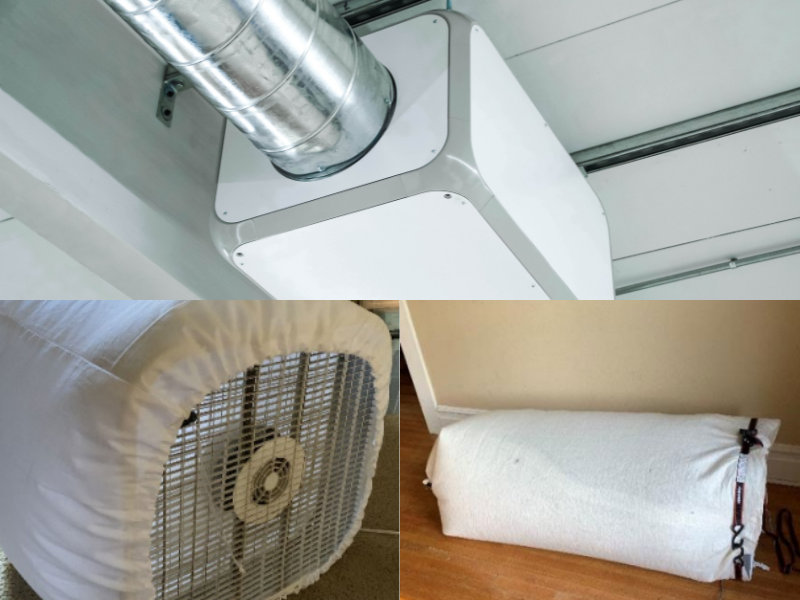
The winning designs: Tatama (above) and The Cocoon (below)
To help address the public health dangers posed by worsening wildfire seasons, EPA recently held a competition to encourage the development of new, affordable air filters. The competition aimed to provide as many people as possible with the resources they need to keep indoor air clean and breathable when outdoor air is thick with smoke.
Air quality and public health experts evaluated initial entries to the Cleaner Indoor Air During Wildfires Challenge in May 2021. Winning teams and honorable mentions then built out prototypes in phase two. Competition judges were looking for safe, low-cost, low-noise designs that would significantly reduce fine particle pollution (PM2.5) for weeks on end. The Washington Department of Ecology supported the EPA initiative during phase one, when Joel Creswell, Ecology’s Climate Pollution Reduction Program Manager, served as a judge. Reflecting on the competition, Creswell highlighted the health disparities it sought to address.
“We have increasing wildfires and people need to protect themselves, but not everyone lives in a modern home with good air filtration,” he said. “This competition successfully got to some new tools that can address the environmental justice challenges we face in a climate-changing world.”
The Cocoon
EPA announced the winners in February, presenting each team with a $50,000 prize. One winning design was “The Cocoon,” a filter developed by Elliot Gall, Ph.D., and his team at Portland State University (PSU). Created with accessibility in mind, The Cocoon consists of a commercial fan, a fabric filter, and a strap to hold them together. The fabric filter is tube-shaped, extending out from the back of the fan to trap dirty particles as they pass through.
With the prize money, the PSU team will continue improving their design through additional testing. Of interest are the benefits of different household fabrics, the effect of washing and re-washing the filter, and the optimal design for mass production. Dr. Gall plans to publish instructional materials online this summer, with the goal of maximizing do-it-yourself builds at a minimal cost.
To commercialize The Cocoon, Dr. Gall hopes to leverage Portland’s outdoor apparel industry to create a reusable, storable fabric filter. “I’m interested in trying to partner with companies that could mass produce a very low-cost filter that fits to common household fans or is adaptable to fit over many types of fans,” he explained.
Tatama
The other winning group was Metalmark Innovations of Cambridge, Massachusetts. Sissi Liu, co-founder and CEO, presented on the novel technology of their device, “Tatama.” Not only is Tatama an extremely effective air purifier, its self-cleaning capability allows filters to be used for up to five years. And, as the only byproducts released during operation are small amounts of harmless air and water, the unit provides a sustainable option for air filtration.
Metalmark’s filtration technology uses nanomaterials modeled after butterfly wings. The filter’s porous structure is coated with a material that breaks down and flushes out collected pollutants. Metalmark advertises their Tatama system for offices, hospitals, schools, and other facilities, Liu said. When outfitted with adequate filtration units, these spaces can offer a reprieve from the otherwise pervasive smoke of recent wildfire seasons.
Following trials in various commercial environments, Tatama is now available for pre-order. Liu encouraged interested parties to visit Metalmark’s website and inquire for further details. “We would gladly speak with any customers to evaluate the fit and quote projects,” she said.
Coming soon to a room near you…
Air filters currently on the market can be expensive and are in high demand — and short supply — by the time smoke blankets a region. But safety measures are critical: in Washington alone, at least 1,100 people die each year from PM2.5 exposure; over the past decade, wildfire smoke has increased deaths from respiratory conditions by 9%. In disadvantaged communities, these dangers and their effects are more potent still.
The solutions emerging from EPA’s prize competition are urgently needed. These soon-to-be available products will increase the number of people who can breathe clean indoor air during intense wildfire events.
To learn more about the winning products and keep tabs on their availability, visit PSU's Healthy Buildings Research Lab page and Metalmark's website.

